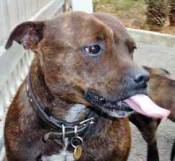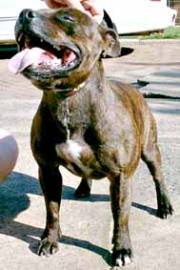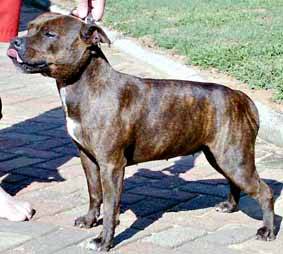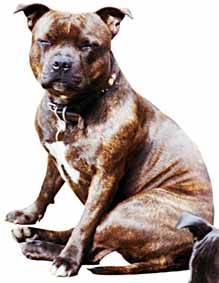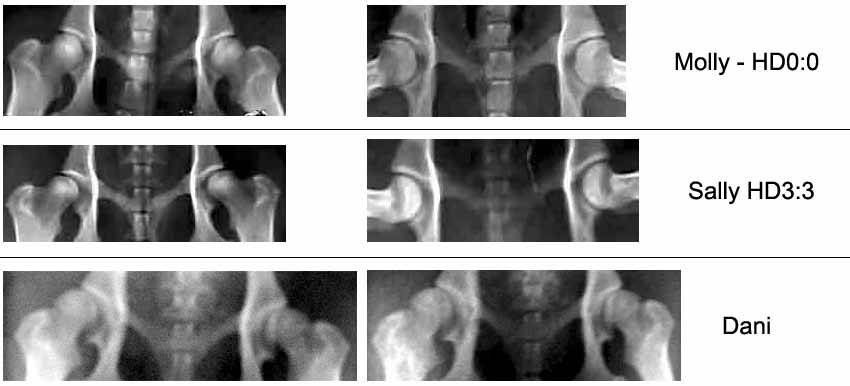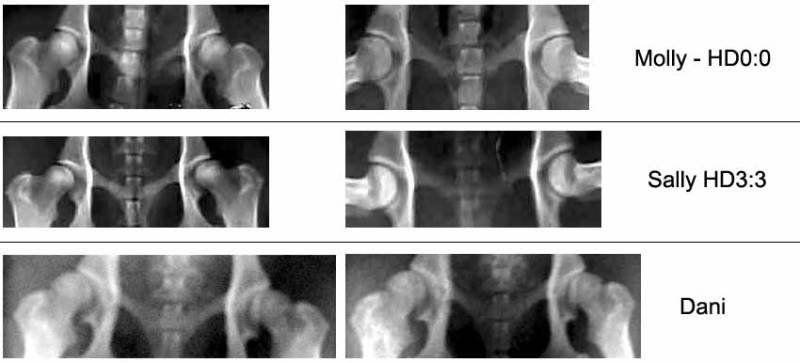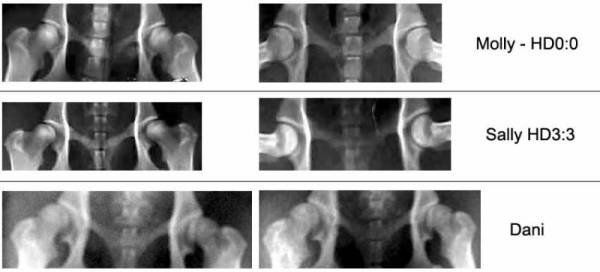First published in Stafford World 2001:
Perhaps the saddest thing of all to me about breeding Staffords is the fact that so few are willing to learn from other people’s experiences – and mistakes. This is one of the major reasons I started Stafford World in the first place – to prove a medium through which we can all share our experiences and learn from others – no matter who they are, or where they live.
It took tremendous courage by Laureen & Eddie Williams “Jodels” (UK), and a handful of others, to make the Stafford community sit up and take notice of the Hereditary Cataract (HC) problem in our Breed. Courage – and a great deal of heartbreak. Who amongst us can truly imagine what it is like to have the best Stafford you ever bred, be branded as a carrier of the HC gene? Not many. The only slight increase in the numbers of Staffords being tested for hereditary eye diseases certainly gives the impression that there are still far too few breeders concerned with this very important issue. “We’ve never had a problem” – that is the usual excuse.
What does it take then for people to start behaving in a responsible and ethical manner when it comes to breeding? Do they really have to go through the agony of it themselves before they realize who crucial it is? It appears so. How depressing that is – especially when so much in-depth knowledge, experience and evidence is so readily available – in conversation, in publications, on the Internet…
Over the years I’ve spoken to a great deal of people around the world – both in writing and face to face – about the various hereditary disease afflicting our Breed. For every person that I have managed to convince that health testing is absolutely essential prior to breeding, there are at least a dozen who have turned a deaf ear.
My personal experience does not lie with an eye disease – it lies with Hip Dysplasia (HD). I have told the story often enough, but I’m putting it into print for the first time now, in the hopes that it will make at least one other breeder, somewhere in the world, start hip scoring their Staffords – and breeding appropriately.
First off, let me assure you that HD occurs in all breeds of dogs – it is not the “big dog” disease that so many people seem to think it is. There is plenty of scientific evidence to support my statement.
When I first started “being serious” about Staffords in 1985, I acquire a show/breeding bitch, and then a dog who “matched up with her lines”. One day, a few litters later, and several years down the road, I got a ‘phone call to tell me that my dog was the father of a hip dysplastic puppy. I didn’t even know what that meant, but I found out soon enough.
What it boiled down to was that “my line” in total had severe HD. That was that then – I gave up “my line” after nearly a 7-year investment in it. Heartbreaking? Soul destroying? Difficult? You bet it was.
Time to start again. In 1991, I bought my new foundation bitch from what appeared to be a “healthy” line, vowing to be thorough about testing forever more, and never breed from any of my dogs that I, or the veterinary experts, were not 100% happy with. That would mean hip scores had to be acceptable and eye tests (for PHPV, HC, Distichiasis, etc) had to be passed – and Stafford with elongated soft palates, or demodectic mange, or luxating patellas, or other hereditary diseases, were not be bred from.
So, with me happily testing all my stock, time merrily passed and my test results came back time and again as “all clear”.
What I had not been doing however, was insisting on the same standards of health from the outside stud dogs I used. I thought, falsely and stupidly, that as long as my stock was okay, there would never be a problem. Some people have called me “clever” – I think not. The inevitable ‘phone call came from my vet one day – “Juanita, this litter of three we’ve just hip scored – they’ve all come back as fails.” I thought I was going to die.
I had used an untested dog on one of my bitches and this resulting litter of three had all got HD. To make matters worse, I had used the same stud dog on another of my bitches (litter sister to the first bitch) a few months after the first mating. There was one puppy from that mating – and she wasn’t old enough to hip score yet. Needless to say, when she was eventually scored, she was diagnosed as severely hip dysplastic. Of course, I asked for the stud dog’s hip score – severely hip dysplastic was the answer, not surprisingly. The lesson learnt here is well and truly engraved on my brain, I promise you.
For some unknown reason, Stafford people generally seem to think that you can tell whether or not a dog has HD by the way it moves. Is it this misconception that makes so few breeders acknowledge the fact that HD is present in our Breed? I will state here and now that it is most certainly NOT true that you can spot HD through movement. All kinds of things affect movement, and HD may, or may not, simply depending on the individual dog.
This edition of Stafford World (2001) is dedicated to one my dogs – Sally (who has a hip score of HD3:3) – for this very reason. Of the three hip dysplastic Staffords I have here at home, Sally is the one who will, from time to time, exhibit the pain caused by her HD and, sometimes, cannot walk at all. On her good days, she is a bundle of fun and an excellent mover (she received 10 CC’s with ease when she was being shown) – and no-one would ever guess she was hip dysplastic. On her bad days, she literally cries – but she never gives up trying. Yes, the hip replacement operation is available, but I feel the risk is too great. Pain management is the route we’ve chosen for Sally – but I know the time is not far away when I will have to make that final, long trip to the vet with her. Sally has only just turned three – and I thank God every day that I didn’t sell her to an unsuspecting pet home …
It is my hope always that anyone who meets Sally, or perhaps reads about her, will learn from her and will start taking the health issues of our Breed seriously. There are no “quick fixes” for these problems – we all have to actively, patiently and passionately work on eliminating them, through continuous testing and scrupulous breeding practices. We can make a good start by sharing our experiences and our health test results – it is a slow, hard road we have to travel therefore. But, let us take a leaf out of Sally’s book and proved that we all possess … “tenacity”.
Additional information as at February 2004:-
Sally is now well past 4 years old, and as you know I took the option of not having the hip replacement operation done when she was diagnosed as severely hip dysplastic just past 12 months old. Apparently there is a high risk that the body will reject the new hips, and then you are left with no choice but to put the dog down.
I started her off with a pain management regime that involved a cocktail of painkillers and joint remedies on a daily basis. That worked quite well at first, but there were still days when she couldn't walk at all and would cry and shiver with the pain. The problems got more and more regular as she eventually developed resistance to all the drugs she was on. It broke my heart to see her suffering like that.
But, for the past 18 months or so, I have been using ONLY Canine Cortaflex and Vitamin C - with marvellous results. I even had her re-x-rayed and re-scored a while ago after continuous usage of Cortaflex - and, believe it or not, she came back with a slightly improved result (HD2:3 as opposed to the first score of HD3:3).
Under the veterinary advice that I’ve received, I give her a Vitamin C tablet a day and her daily dose of Cortaflex. Cortaflex does NOT cure HD, but it helps to slow down the degeneration of the hips and the resulting arthritis (which is what mainly causes the pain). There will be a point in time when it no longer helps, but I truly believe that to be many years away now, instead of only many months if I was giving her nothing.
Make no mistake, she still has days when she is sensitive in her whole back-end and I am always aware of her problem. But, she has a normal life now - she goes on the beach with the other dogs, and races around and bounces from rock to rock just like the rest of them. She is probably my most active and agile dog actually. I do, though, make sure that she never goes further than I have learned she can cope with. The point is that you used to be able to pick her out of the crowd before - the one with a problem - but now she looks and behaves and, more importantly, FEELS normal.
Cortaflex is made in the UK and, I think, costs about £25 a bottle, which lasts about 6 to 8 weeks. You start off with 10mL (2tsps) a day for the first week, and then 5mL (1tsp) a day thereafter for life. It tastes quite sweet (syrupy) and I just put it on her food, and she has never turned it down.
Canine Cortaflex:
Mucopolysaccharides (source of Chondroitin Sulphate) - 145mg/5mL
Glucosamine - 100mg/5mL
Methylsufonylmethane (MSM) - 50mg/5mL
Manufacturer:
Horsham Nutraceutical-UK
7 Lawson Hunt Business Park
Howsham
W. Sussex
RH12 3JR
Tel: 01403 255511 / 255809
Fax: 01403 241083
I've made a picture comparison here of Molly (HD0:0), Sally (HD3:3 pics) and Dani (as yet unscored).
In this country, we have 5 grades of scores, but to put it in simple terms it means this:
HD0:0 - no HD
HD1:1 - mild
HD2:2 - moderate
HD3:3 - severe
HD4:4 - very severe
In the UK (and Australia and New Zealand) the system is different - each hip is given a score and the two numbers are added together to give a total:
between 0 and 12 - no HD
between 13 and 30 - mild
between 31 and 54 - moderate
between 54 and 66 - severe
over 66 - very severe
As you can see from the picture comparison, Dani is extremely bad. One thing to note is that Dani was x-rayed in only position. We have to have them x-rayed in two positions here in South Africa – one with legs straight down (like Dani’s) and the other with legs straight out (the "frog" position). So the true comparison in my picture is the three left hand side x-rays (and Dani's right hand one too). Molly and Sally's right hand pics shouldn't be compared to Dani's as she hasn't got one in that position, but I've included them so you can see the difference between Molly and Sally.
Remember that Dani may never get pain from the HD itself. It often happens that they have no problems with their hips until the arthritis starts setting in, and then it advances much quicker than a dog without HD. You can see there is a large deposit on Dani's right hand "ball" which is a sign that the arthritis is setting in there.
I know that the patella luxation is the thing causing all the problems and the pain right now - but that is going to be permanently solved with the surgery. I'm afraid to say that it is her hips that in the long term need the care. My advice is to get her onto the Cortaflex right now and keep her on it permanently.
The fact remains that the majority of breeders (especially in the UK) do not even acknowledge that this is a problem in our Breed. Until they start waking up to it, this kind of dreadful heartache is always going to be with us. So much progress has been made in the other major countries on this issue - yet the UK lags light years behind South Africa, Australia, the USA, Scandanavia, etc. For example, I have now bred 5 generations of scored dogs - 5 generations is a lot of dogs on a global scale - so you can see how far behind the UK is, especially when you think that, to date, only ONE UK Ch has even been hip scored – Ladarna Birthday Boy.
And, NO – this is not a witch-hunt! This is an appeal to those breeders who are not dealing with the HD problem in Staffords, to PLEASE, PLEASE start taking care. Let us take every step we can to make sure that dogs like Sally and Dani are not bred. We claim as breeders to be “breeding to improve the breed” – so let’s actually start doing that.
Give Dani a special, gentle kiss right on her stop especially from Sally and me.
Juanita Crawford
Crossbow Staffordshire Bull Terriers (South Africa)

